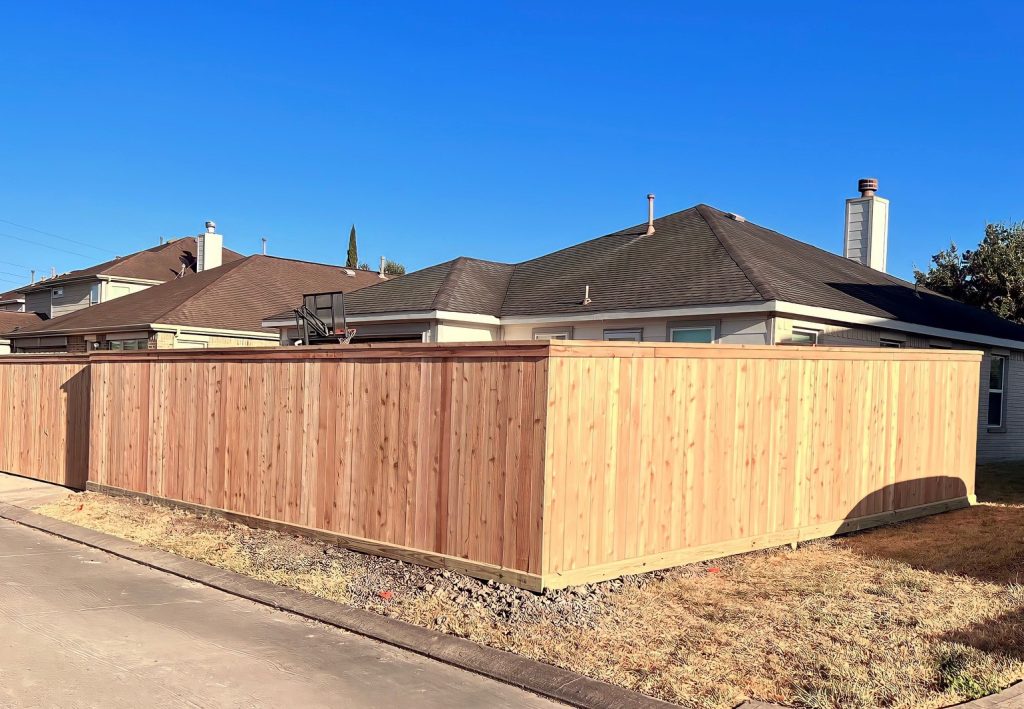Complete Guide to Wood Privacy Fences: Installation, Designs, and Maintenance
Wood privacy fences offer advantages, including heightened privacy by creating a strong barrier between your property and the surrounding area. They also provide added security, reduce noise and enhance the appeal of your outdoor space. Moreover, wood is a material that can be customized according to your specific design preferences.

Types of Wood Privacy Fences
Wood privacy fences are an option for homeowners due to their natural beauty, versatility and durability. When choosing a wood privacy fence several factors need to be considered. These include the type of wood used the desired level of privacy and the overall design. Lets explore some types of wood privacy fences.
1. Solid Board Fence: This kind of wood privacy fence offers privacy as it consists of solid boards placed side by side without any gaps. It forms a barrier that blocks views from both sides. Solid board fences can be built using types of wood such as cedar or pine depending on budget constraints and aesthetic preferences. They are also known for their strength and ability to withstand weather conditions.
Imagine having a backyard, with neighbors in proximity. A sturdy wooden fence can effectively block the view from your neighbor’s yard while adding a pleasing backdrop to your outdoor area.
2. Shadowbox Fence: The shadowbox fence has a design where the boards alternate on each side of the fence panel creating an attractive pattern that allows air and light to pass through. This type of fence offers a level of privacy while still maintaining an open feel. It is often preferred in neighborhoods where privacy is desired without seclusion. For example, if you have a backyard with a view or beautiful landscape a shadowbox fence would provide some privacy without completely obstructing the picturesque surroundings.
3. Lattice Top Fence: A lattice top fence combines the advantages of a wooden fence with decorative lattice work at the top. The lattice adds a touch while allowing some visibility and airflow. This design is perfect for homeowners who value privacy without sacrificing style. Lattice top fences are commonly used as perimeter fences or, around gardens and pool areas. For instance, if you have a garden in your yard that you want to protect from wandering animals a lattice top fence would create an enchanting enclosure while still allowing you to showcase the beauty of your garden.
4. Spaced Picket Fence: Spaced picket fences are often associated with a traditional and welcoming look. This style consists of spaced vertical pickets attached to horizontal rails creating gaps between each picket. While they may not offer much privacy, spaced picket fences are ideal for defining boundaries, enhancing the curb appeal of your property, and maintaining an open atmosphere.
Imagine having a yard with a stunning flower bed that you want to showcase to passersby. Choosing a spaced picket fence would allow others to admire your flowers while still clearly marking your property lines in an inviting way.
By understanding the options for wood privacy fences available homeowners can make well informed decisions based on their desired level of privacy, design preferences and budget considerations. Post and Panel Design
The post and panel design is a classic choice for wood privacy fences. It offers a timeless look while ensuring durability and stability. In this design, sturdy posts are firmly secured into the ground at regular intervals, supporting long panels that run horizontally between them. The result is a strong and visually appealing fence that provides both privacy and security.
Posts: The foundation of any post and panel wood privacy fence is its vertical posts. These posts are typically made of pressure-treated wood or cedar for increased resistance against rot and insects. They play a crucial role in providing stability and support to the fence structure.
Picture yourself installing a post and panel fence in your backyard. By using pressure-treated wood for the posts, you ensure the longevity of your fence, even in areas where the soil may be prone to moisture.
Panels: The panels in a post and panel design are the horizontal boards that run between the posts. These boards can be installed tightly together for maximum privacy or with gaps for a more open feel. Common sizes for fence panels range from 6 to 8 feet wide and can be customized to accommodate specific design preferences.
Suppose you have a backyard where your children frequently play. Opting for fence panels with minimal gaps ensures their safety by preventing them from wandering outside while maintaining the desired level of privacy.
Installation: Installing a post and panel wood privacy fence requires careful planning and precise measurements. It’s essential to set the posts at a consistent height above ground level and align them properly to maintain uniformity throughout the fence line. Professional installation is recommended to ensure the best results.
Imagine hiring a professional team to install a post and panel wood privacy fence around your property. Their expertise ensures that all posts are evenly spaced and leveled, guaranteeing an attractive final result that stands the test of time.
Whether you seek complete seclusion or just want to add a touch of elegance to your property, the post and panel wood privacy fence design offers both functionality and visual appeal.
Picket Design
When it comes to wood privacy fences, one of the key elements to consider is the picket design. The design of the pockets determines not only the level of privacy provided by the fence but also its overall aesthetic appeal. There are various picket designs available, each offering a unique look and feel. Let’s explore some popular options:
Traditional Dog-Ear Pickets: This classic design features pickets with the top corners cut at an angle, resembling the ear of a dog. It provides a timeless and rustic look that complements a wide range of architectural styles.
Scalloped Pickets: Scalloped pickets are characterized by their curved or arched tops, adding a touch of elegance and charm to the fence. This design works well for homeowners looking for a more decorative and ornate appearance.
Board-on-Board Pickets: In this design, two vertical boards overlap, creating a double-layered effect. Board-on-board pickets offer enhanced privacy as they completely block the line of sight when viewed head-on.
Shadowbox Pickets: Shadowbox pickets consist of alternating overlapping boards on both sides of the fence. This design allows air and light to pass through, while still maintaining privacy. It’s an excellent option for properties that desire some visibility without sacrificing security.
Stockade Pickets: Stockade pickets involve placing closely spaced vertical planks side by side, providing maximum privacy and a solid barrier. This design is ideal for homeowners seeking maximum seclusion.
As you can see, the picket design you choose for your wood privacy fence plays an important role in achieving the desired functionality and visual appeal. Now let’s explore some of the advantages of using wood as the material for your privacy fence.
Advantages of Using Wood for Privacy Fences
Wood has been a popular choice for privacy fences for generations, and it’s not hard to see why. Here are some of the advantages of using wood:
Natural Beauty: Wood offers a warm, natural aesthetic that blends well with various architectural styles, from traditional to contemporary. The organic appeal of wood can enhance the overall appearance of your property and add value to your home.
Versatility: Wood gives you the freedom to customize your fence design according to your preferences and needs. It can be easily shaped, cut, and painted or stained in different colors, allowing for endless possibilities in terms of creativity and personalization.
Cost-Effective: Compared to other fencing materials like wrought iron or vinyl, wood is often more affordable. While prices may vary depending on the type of wood chosen, wood generally provides a cost-effective option for homeowners on a budget.
Easy Installation and Repair: Wood fences are relatively easy to install, especially when compared to more complex materials like brick or stone. Additionally, if any damage occurs over time or due to external factors, individual pickets or panels can be replaced without having to replace the entire fence.
However, it’s important to note that wood may require regular maintenance, which can include staining or painting every few years and periodic inspections for rot or insect damage. Some homeowners may find this upkeep demanding, while others enjoy the opportunity to preserve their fence’s longevity and appearance through proper care.
- Wood is a popular choice for privacy fences due to its natural beauty, versatility, cost-effectiveness, and easy installation and repair. It offers a warm and organic aesthetic, can be customized according to preferences, and is often more affordable than other materials. However, it does require regular maintenance to preserve its appearance and longevity.
Materials, Installation, and Costs
When it comes to wood privacy fences, making informed decisions about materials, installation, and costs is crucial. Let’s explore these aspects in detail to help you create the ideal fence for your needs.
Materials play a significant role in the appearance, durability, and maintenance requirements of your wood privacy fence. Common options include cedar, redwood, pine, and cypress. Each type of wood has its unique characteristics that impact its longevity and resistance to rotting, warping, and insect damage. Cedar and redwood are known for their natural resistance to decay and insects, making them highly desirable choices for outdoor structures. Pine is more affordable but may require additional coatings or treatments for enhanced durability. Cypress falls somewhere in between, offering good longevity with minimal maintenance.
Imagine living in a neighborhood with tall cedar wooden privacy fences that elegantly blend with the natural surroundings. The aromatic scent wafts through the air as you sit in your backyard oasis, enjoying both privacy and aesthetic pleasure.
Remember: Choosing the right wood material will have long-term implications for your fence’s lifespan and overall maintenance requirements.
Installation Procedure starts by marking the fence layout, measuring distances accurately between posts. Digging post holes at consistent depths is crucial to ensure stability. Once the holes are dug, set the posts securely in concrete or gravel and allow proper curing time before attaching the rails and boards. This step requires precision to ensure straight lines and even spacing between boards. Finally, applying finishes or sealants can enhance the wood’s resistance to weathering factors like sunlight, moisture, and termites.
Considering costs is another essential aspect when planning your wood privacy fence. Various factors affect the overall expenses, including the size of the area to be fenced, choice of wood material, desired height, additional features like gates or decorative elements, and contractor fees. It’s advisable to obtain several quotes from reputable contractors to compare prices and evaluate their expertise in wood privacy fence installations.
Remember: When budgeting for your wood privacy fence, consider the long-term benefits and potential savings on maintenance or replacement costs due to choosing quality materials and professional installation.
Different Woods and Their Durability
Choosing the right type of wood for your privacy fence is essential as it directly affects its durability and longevity in outdoor conditions. Let’s explore some common types of woods used for Privacy fences:
- Cedar: Known for its natural resistance to rotting, decay, and insects. Cedar is a popular choice due to its classic beauty, durability, and low maintenance requirements.
- Redwood: Similar to cedar, redwood offers excellent resistance to decay and insects. It has a beautiful reddish hue that ages gracefully over time.
- Pine: Pine is an affordable option but requires regular staining or painting to enhance its durability. It is prone to warping if not properly maintained.
- Cypress: Cypress offers good resistance against rotting and decay. It has natural oils that act as preservatives, extending its lifespan.
Imagine having a cedar wood privacy fence surrounding your yard. Not only does it provide excellent privacy, but its natural beauty adds charm and elegance to your outdoor space. The durability of cedar ensures that it weathers the elements with grace, requiring minimal maintenance over the years.
Keep in mind that regular maintenance such as staining or sealing can extend the lifespan of your wood privacy fence, regardless of the wood type selected.
Ultimately, when choosing the right wood for your privacy fence, factors like climate, budget, desired aesthetics, and maintenance considerations should all be taken into account.
Installation Procedure and Costs
Installing a wood privacy fence requires careful planning and execution to ensure its durability and functionality. Here is a step-by-step guide to help you understand the installation procedure:
- Planning and Permitting: Start by determining the layout and dimensions of your fence, taking into account local regulations and obtaining any necessary permits. It’s important to establish property lines accurately before commencing the installation.
- Gathering Materials: Next, gather all the materials needed for your wood privacy fence, including the wooden panels or pickets, posts, cement, nails or screws, gate hardware, and any additional decorative elements. Depending on your preferences, you can choose from various wood species such as cedar, pine, or redwood.
- Marking and Digging Post Holes: Use stakes and string to mark the location of each post along the intended fence line. Dig holes using a post hole digger or an auger. The depth of the holes will depend on local building codes but is typically around one-third of the total post length.
- Setting Posts: Place each post in a hole and ensure it is level vertically and horizontally. Fill the hole with concrete mix according to manufacturer instructions, making sure it completely surrounds the post. Allow the concrete to cure before proceeding.
- Attaching Rails and Panels: Once the posts are set, attach horizontal rails between them using screws or nails. Then, attach the wood panels or pickets vertically to these rails, ensuring they are evenly spaced and level.
- Building Gates: If you plan to include a gate in your wood privacy fence, construct it separately using appropriate hardware and hinges. Install the gate in a way that complements the overall design of your fence.
- Finishing Touches: Finally, apply a weather-resistant finish or stain to protect the wood from moisture, rotting, and damage caused by UV rays. Regularly inspect and maintain your fence, addressing any issues promptly to prolong its lifespan.
The cost of installing a wood privacy fence can vary depending on several factors, including the size of the fence, the type and quality of the wood, additional features or decorative elements, and the region in which you reside. On average, homeowners can expect to spend between $1,500 and $4,000 for a standard wood privacy fence installation.
For instance, let’s say you live in suburban Houston, Texas, and plan to install a 6-foot-tall cedar privacy fence around your backyard. Considering a yard size of 100 linear feet, the estimated cost may be around $3,000 to $3,800. Keep in mind that these figures are approximate and may differ based on specific requirements and market conditions.
Maintenance of Wood Privacy Fences
Wood privacy fences add an aesthetic appeal to residential properties while providing security and solitude. To ensure their longevity, periodic maintenance is essential. Here are some key aspects to consider when maintaining your wood privacy fence:
- Cleaning: Regularly clean your fence using a mild detergent or specialized wood cleaner followed by rinsing with water. This helps remove dirt, grime, moss, and mildew that can accumulate over time.
- Staining or Sealing: Apply a protective stain or sealant every few years to prevent moisture penetration and damage from UV rays. This also enhances the natural beauty of the wood and extends its lifespan.
- Inspecting for Damage: Regularly inspect your wood privacy fence for signs of damage such as loose screws or nails, cracked or split boards, rotting sections, or insect infestations. Promptly address these issues to prevent further deterioration.
- Trimming Vegetation: Trim any plants or vegetation growing near the fence line that could lead to moisture retention or cause damage to the wood. This includes trimming tree branches that may rub against or fall onto the fence.
- Avoiding Contact with Soil: Ensure the bottom of your wood fence is not in direct contact with the soil, as this can lead to moisture absorption and rotting. Use concrete footings or pressure-treated wood for the posts to elevate them above ground level.
- Winter Preparations: Before winter arrives, make necessary preparations such as removing debris near the fence, ensuring proper drainage, and protecting the fence from heavy snow buildup that could lead to structural damage.
By following these maintenance practices, you can prolong the lifespan of your wood privacy fence and enjoy its beauty and functionality for years to come.








